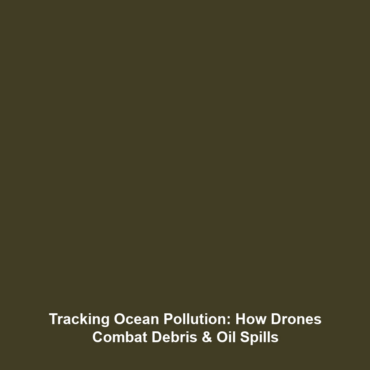How Drones Are Used to Track Ocean Debris, Oil Spills, and Other Pollutants
In recent years, the application of drones in environmental monitoring has gained significant attention. Drones are revolutionizing our ability to track ocean debris, oil spills, and other pollutants, thereby playing a crucial role in maintaining marine ecosystem health. The utilization of unmanned aerial vehicles (UAVs) in these contexts not only enhances data collection but also improves the response strategies to various environmental crises. This article delves into the significance and methodology behind using drones to monitor pollutants, providing a comprehensive overview of their impact in the field of Drones in Science.
Key Concepts
Drones have transformed environmental monitoring practices, particularly in tracking pollutants in our oceans. The major concepts surrounding their use include:
- Remote Sensing: Drones equipped with sophisticated sensors collect data on ocean surface conditions, identifying areas affected by pollutants.
- Real-Time Monitoring: UAVs facilitate the immediate collection and transmission of data to scientists, enabling quick responses to environmental threats.
- Data Integration: Drones integrate with existing environmental data systems, allowing for a more comprehensive understanding of pollutant distribution.
Applications and Real-World Uses
There are numerous applications of drones to track ocean debris, oil spills, and other pollutants. Some significant real-world uses include:
- Oil Spill Response: Drones are deployed to locate and map the extent of oil spills in real-time, significantly enhancing cleanup strategies.
- Marine Debris Monitoring: UAVs track floating plastic debris, helping researchers and environmentalists devise strategies for reducing ocean pollution.
- Water Quality Assessment: Drones collect surface water samples in hard-to-reach areas, allowing for timely assessments of contamination levels.
Current Challenges
Despite their growing application, there are several challenges of using drones to track ocean debris, oil spills, and other pollutants:
- Regulatory Issues: Navigation and flight regulations can limit where and how drones are deployed, hindering comprehensive monitoring.
- Technical Limitations: Battery life and data transmission range can restrict flight durations and the amount of data collected.
- Environmental Factors: Weather conditions, such as high winds or rain, can affect drone performance and data accuracy.
Future Research and Innovations
The field of Drones in Science is rapidly evolving, with ongoing research focusing on:
- Improved Autonomous Systems: Next-generation drones with enhanced AI for better navigation and decision-making during missions.
- Advanced Sensor Technology: Development of more sensitive and versatile sensors to track a broader range of pollutants.
- Collaboration with Machine Learning: Utilizing data analytics to predict and model pollutant dispersion patterns effectively.
Conclusion
In summary, drones are invaluable tools for tracking ocean debris, oil spills, and other pollutants, playing a significant role in the broader scope of Drones in Science. Their ability to provide real-time, accurate data not only aids in environmental monitoring but also enhances response efforts to pollution disasters. As technology continues to advance, the effectiveness and applications of drones in this field will surely expand. For further reading, explore our articles on Drones in Environmental Science and Ocean Pollution Management Strategies.

Leave a Reply